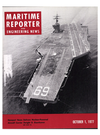
Page 10: of Maritime Reporter Magazine (October 1977)
Read this page in Pdf, Flash or Html5 edition of October 1977 Maritime Reporter Magazine
LNG Shipping—
What Prospects Now?
In recent months, there have been many press and industry re- ports to suggest a growing inter- est in LNG shipping, the reports being a mixture of favorable and unfavorable news for owners and operators of LNG carriers, but leaning toward a generally im- proved outlook for LNG shipping.
This apparently improved outlook is in contrast to historical devel- opments in world LNG shipping expectations. The anticipated fu- ture boom in LNG shipping de- mand, which has consistently been forecast since the inception of seaborne LNG export trades in the mid-1960s, has continually suffered postponement in the past.
The result is that at mid-1977, there were still only nine base- load LNG export trades in oper- ation, which together generate a shipping capacity requirement of only 1.5 million cubic meters per annum, while the existing supply of LNG carriers is almost 2.9 million cubic meters, nearly dou- ble that level. Indicatively, at end-July 11, LNG carriers aggre- gating 1.2-million-cubic-meters capacity were laid up or had been inactive for two months or more.
At present, therefore, there is a gross oversupply of very expen- sive shipping capacity in the LNG trades, a situation which, on the basis of currently scheduled fu- ture developments, will not be cor- rected until at least 1982.
However, during the next eight years as many as 15 new LNG export projects could come on- stream, and these could increase world LNG shipping requirement in 1985 to as much as 15.1 mil- lion cubic meters per annum, 7.6 million cubic meters more than the total capacity of the LNG fleet currently scheduled for 1985.
From the known planned devel- opments in world LNG export trades and LNG shipping supply, the expected future balance in
LNG shipping supply / demand, expressed in numbers of the popular-sized 125,000-cubic-meter ship, can be calculated as follows: (Supply Surplus) end of year 1977, number of ships 9; end of '78, number of ships 12; end of '79, number of ships 19; end of '80, number of ships 18; end of '81, number of ships 17; (Supply
Deficit) end of '82, number of ships (8) ; end of '83, number of ships (40) ; end of '84, number of ships (53) ; and end of '85, num- ber of ships (61).
Between now and 1985, there- fore, as many as 61 new orders for 125,000-cubic-meter-sized
LNG carriers could be necessary to meet the incremental LNG shipping demand forecast to be generated between 1982-85. How- ever, the expected acceleration in
LNG shipping demand in this lat- ter period is still uncertain. The boom in LNG shipping could be postponed, once again, to beyond 1985.
Recent developments improving the outlook for LNG shipping in- clude the coming on-stream or the impending startup of some new projects and a reaffirmation of the status of other future projects. The Abu Dhabi Das
Island gas export project came on-stream at the end of April, although deliveries to Japan, and indeed the entire operation, have been held up due to the cargo contamination by metal bolts, suffered in the first shipload. This suspension (which involves strip- ping down most of the hardware involved — liquefaction plant, the gas carrier and reportedly the shipyard) will continue until the source of the bolts is located.
Two other major trades are due for imminent startup: (a) the first half of the Indonesia—from
Badak in East Kalimantan — to
Japan LNG export project due to have started August 1 (the sec- ond half — from Arun in North
Sumatra — is scheduled to come on-stream early in 1978), and (b) the first major trade to USEC, 10 Maritime Reporter/Engineering News

 9
9

 11
11
